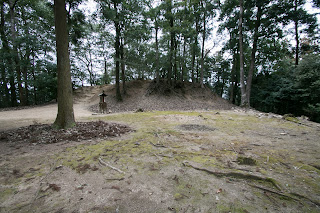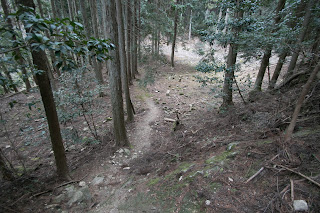Yoshida Koriyama Castle
-Proverb of three arrows-
Overview
Name: Yoshida Koriyama Castle (Yoshida Koriyama-jo)
Alias: Koriyama castle
Place: Yoshida-cho Aki Takada city, Hiroshima
Type: Mountain castle
Built: Originally in 14th century, expanded in 16th century
Remaining remnants: Stone walls and clay walls
Title: 100 famous Japanese Castles, Designated national historical site
Brief History
Yoshida Koriyama castle (吉田郡山城, also called as Aki Koriyama castle based on location name) is located on Koriyama mountain in Yoshida basin, at Aki Takada city which is the one at the north part of Hiroshima prefecture.
Yoshida basin is a small basin in the mountainous area, but at the place where upstream of two large rivers, the one of Gonokawa river which flows northward to Sea of Japan, and another is Otagawa river runs southward to Setonaikai Sea. And just apart from the basin, Nutagawa river flows toward southeast to current Mihara city. Because of this geographical condition, Yoshida basin is an important area of communication at this area. Later Mouri clan maximized this condition and became the ruler of Chugoku region.
Origin of Aki Koriyama castle and Mouri clan
Aki Koriyama Castle was a main base of Mouri clan from 14th century to 1591, and originally a small castle was built at the ridge at southeast part of the mountain. Mouri clan was a descendant of Hiromoto Oe (1148-1225), a close retainer of Yoritomo Minamoto (1147-1199) who established Kamakura Shogunate. Hiromoto was originally a noble at Kyoto city, and contributed to build a political structure of Kamakura Shogunate. But later Oe clan was involved in political conflicts and lost its position.
Around the beginning of 14th century, a branch family of Oe clan which named as Mouri clan moved to their territory at Aki province (western part of Hiroshima prefecture) to avoid political conflict of Kamakura area. Throughout Muromachi era, Mouri clan gradually grew into a major local lord and became the leader of alliance of local lords at eastern part of Aki province and western part of Bingo province (eastern half of Hiroshima prefecture).
But at the same time, Mouri clan and other local lords were involved in the conflict of surrounding strong powers and struggled. In the latter half of 15th century, Aki province became the target of struggle between Ouchi clan, a wealthy governor of Suo province and Nagato province (Yamaguchi prefecture), and Yamana clan which was one of the highest retainer of Muromachi Shogunate which managed many provinces of Chugoku region as governor.
After the downfall of Yamana clan as a result of the battle of Onin continued from 1467 to 1477, Amago clan which was the lord of Gassan Toda castle rapidly rose at Izumo province (Shimane prefecture) under its intelligent and dauntless leader Tsunehisa Amago (1458-1541). At first Mouri clan belonged to Ouchi clan, but under the pressure from Amago clan Mouri clan moved between two powers. In addition to external pressures, Mouri clan also had to cope with their strong and non obedient retainers.
Period of Motonari Mouri
The situation has changed when Motonari Mouri (1497-1571) became a leader of Mouri clan at 1523. Motonari had excellent skill of intelligence, and also was good at tactics. Motonari moved between Ouchi and Amago clan but finally chose Ouchi clan. In response to this, Amago clan attacked Aki Koriyama castle by large army in 1540, but Motonari besieged at Aki Koriyama castle and fought well under the support from Ouchi clan, then finally rejected Amago army and made decent damage for them. From this defeat Amago clan started to decline. Motomari also ruined non obedient retainers and fixed internal situation.
In 1551, in Ouchi clan there was a coup d’etats by Takafusa Sue (1521-1555, later Harukata Sue), deputy governor of Nagato province named, as the accident of Daineiji temple, and Ouchi clan dominated by Harukata significantly lost is power. At first Motonari tacitly supported Harukata, but once Ouchi clan fell, Motonari aimed at independence and became against to Takafusa insisting revenge of former master.
Furious Takafusa Sue attacked Mouri clan by large army, but Motonari made Takafusa purge his intelligent staff by trick, and let Takafusa’s army land to Itsukushima, a small island which is famous for Itsukushima Shrine. At this island Motonari made a sudden attack to Sue army, and Murakami navy supported Motonari burnt out ships of Sue army. Talafusa tried to leave from the island but there was no ship, then finally killed himselve. This battle is called as the battle of Itsukushima, and famous of turning over inferior situation along with the battle of Okehazama.
Proverb of three arrows
After the battle Motonari occupied Suo province and Nagato province, the territory of Ouchi clan and Sue clan. As a result, Motonari could reject the domination of Ouchi clan without bad reputation. Motonari aimed at further expansion to whole Chugoku region supported by his three sons. Takamoto Mouri (1523-1563), the eldest son and who had a good sense of balance, located in Koriyama castle and managed general matters of the house.
Second son Motoharu Kikkawa (1530-1586) who was adopted by Kikkawa clan and the lord of Hinoyama castle (Hiroshima prefecture), was a brave commander, and responsible for Sanin area (north half of Chugoku region). On the other hand, the third son Takakage Kobayakawa (1533-1597), who was also adopted by Kobayakawa clan and the lord of Niitakayama castle and Mihara castle (Hiroshima prefecture), was good at intelligence and looked Sanyo area (south half of Chugoku region).
According to a tale it might be a fictional one, one day Motonari made a lecture for these three brothers stating that "One arrow is easy to fold, but three tied arrows are difficult to do so. It is necessary for you three to cooperate with each other for the growth of Mouri clan". Apart of the truth of this tale, three brothers actually united and contributed to the leap of Mouri clan.
Supported by the activity of these three sons, Motonari finally overthrew Amago clan in
1566, and became a ruler of Chugoku region. Along with territoral expansion, Koriyama castle was moved to the top of the mountain, reformed and became a huge castle with three story main tower covered all part of Koriyama mountain.
Structure of Aki Koriyama Castle
Koriyama mountain is a corned shaped mountain having ridges at whole direction, and the shape of Aki Koriyama castle utilized this terrain. At the top of the mountain, there area core areas of the castle such as central area, secondary area, Mikura-Yashiki area or third area. These core parts were originally protected by stone walls and Masugata style gate complex, and there might be a main tower over the basement at the inner part of central area.
Many terraces are built at ridges radially spreads from hilltop area. At southwest, a large terraces named as Sedamarino-dan or Yagurano-dan continues over 300 meter. Other than this, there are several large areas such as Hagonomaru, Himeino-dan, Tsuriino-dan, or Kamayano-dan at the below of core areas. As these areas are built at steep ridges, the road connects core areas and these outer areas are very steep.
Total size of the castle reached to 600 meter long and 500 meter wide, and is one of the largest castle in Chugoku region. At the south of castle area, there is Ozakimaru outer fort which was the original are of the castle. This castle was a small one of about 200 meter long but was securely protected by steep slopes and walls.
After Motonari's death to abolition
After Motonari’s death Mouri clan further extended to Harima province (Hyogo prefecture), but then a conflict with central ruler Nobunaga Oda (1534-1582) began. Mouri clan lost territories before Hideyoshi Hashiba (1537-1598, later Hideyoshi Toyotomi), the regional commander of Oda clan, and was on the barge of extinction in 1582.
But in that year the incident of Honnoji, a coup d eta to Nobunaga by Mitsuhide Akechi (1528-1582), a regional commander of Oda clan occurred, and Hideyoshi made peace with Mouri clan in haste, then returned to Kyoto and defeated Mitsuhide.
Later Mouri clan became an important lord under Toyotomi government, built a new castle in Hiroshima near the sea and moved to Hiroshima castle in 1591. Koriyama castle was abolished after a short time, and at beginning of Edo era, to prevent to be used by Christian rebellion like the rebellion of Shimabara (1637-1638), buildings and stone walls of the castle were totally demolished. Currently the site of this castle is used as a historical park.
Access
Bus or taxi from JR West Geibi-sen line Yoshidaguchi station. 20 minutes drive from Chugoku Jidoshado Expressway Miyoshi interchange. 60 minutes walk from hillside entrance to hilltop castle.
Related Castles
Gassan Toda castle -Rapid rise and fall of Amago clan-
Mihara Castle -Naval base castle at Inland Sea-
Hiroshima Castle -Deviation from clan's tradition on castle-
Hagi Castle -Beautiful combination of mountain, sea and stone walls-
Niitakayama Castle -Intellectual pillar of Mouri clan-
Hinoyama Castle -Military pillar of Mouri clan-























































































































































































































































































































































































































































































































































No comments:
Post a Comment